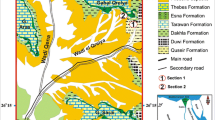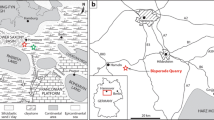Abstract
Upper Cretaceous depositional systems of the Zagros area were influenced by a series of local and regional tectono-sedimentary events such as progressively southwestward foreland basin migration, which locally was overprinted by salt movements. The Maastrichtian interval is characterized by filling out of the NE foredeep by obducted units and development of SW facing ophiolitic and radiolite nappe in the most interior parts of the Fars area. This tectono-sedimentary loading led to the migration of the mid-foreland basin bulge to the southwest. To reconstruct the depositional settings during this time, three outcrop sections (Kuh-e Chadur, Gach, and Parak) and two wells (Pishvar-1 and Bavush-1) are organized in an SW–NE trending cross section. Maastrichtian sedimentary succession is introduced by pelagic marls of the Gurpi Formation, carbonates of the Tarbur, and evaporates of the Sachun formations along with obducted radiolaritic and ophiolitic complexes. Field and microscopic investigations led to the recognition of several facies’ belts in carbonate domain including intertidal, restricted and open lagoonal, reefal, open marine, and basinal settings, which organized in one regional third- and five local fourth-order sequences that generally show a sharp decreasing trend in sequence thickness of Maastrichtian deposits from NE toward SW. Facies’ variations along this transect show that sequences 1 and 2 are present only in the northern part of the basin. Sequence 3 dominated by rudistid facies, showing progradational pattern toward the southern basinal setting over the time-equivalent pelagic marls of the Gurpi Formation. Sequence 4 has mainly composed of inner shelf deposits in the north and progrades into the outer shelf deposits, toward the south. Sequence 5 consists mainly of dolomites and evaporites of restricted lagoon (Sachun Formation). Accordingly, salt tectonics has resulted in thickness and facies’ variations as well as sequence patterns. In addition, uplifting and migration of the bulge, controlled the exposure area and subsequent diagenetic events such as meteoric dissolution, dolomitization, neomorphism, brecciation, and Fe-staining. Halokinetic events show a strong influence on the intensity and development of diagenetic processes, particularly dolomitization and dissolution.

















Similar content being viewed by others
References
Abramovich S, Keller G (2002) High stress upper Maastrichtian paleoenvironment: inference from planktonic foraminifera in Tunisia. Palaeoclimatology 178:145–164
Abyat A, Afghah M, Feghhi A (2013) Stratigraphy and foraminiferal biozonation of the upper cretaceous sediments in Southwest Sepid Dasht, Lurestan, Iran. World Appl Sci J 28(9):1199–1207
Abyat A, Afghah M, Feghhi A (2015) Biostratigraphy and lithostratigraphy of Tarbur Formation (Upper Cretaceous) in southwest of Khoram Abad (southwest Iran). Carbonates Evaporites 30:109. doi:10.1007/s13146-014-0218-1
Afghah M, Yaghmour S (2014) Biostratigraphy study of Tarbur Formation (Upper Cretaceous) in Tang-e Kushk and East of Sarvestan (SW of Iran). J Earth Sci 25(2):263–274
Alavi M (2004) Regional stratigraphy of the Zagros fold-thrust belt of Iran and its Proforland evolution. Am J Sci 304:1–20
Alavi M (2007) Structures of the Zagros fold-thrust belt in Iran. Am J Sci 307:1064–1095
Amiri Bakhtiar H, Taheri A, Vaziri-Moghaddam H (2011) Maastrichtian facies succession and sea-level history of the Hossein-Abad, Neyriz area, Zagros Basin. Hist Biol 23(02–03):145–153. doi:10.1080/08912963.2010.498582
Asgari Pirbalouti B, Dehghanian MS, Rasti E (2012) Geochemical study of Late Cretaceous Sediments in Kuh-e Dezdaran Section, in Central Zagros of Iran. Adv Environ Biol 6(9):2541–2548
Asgari Pirbalouti B, Mirzaie M, Jafarian MA, Khosrow Tehrani K, Afghah M, Davoudi Fard Z (2013) Biostratigraphy and regional aspects of the Tarbur Formation (Maastrichtian) in Central Zagros, Southwest Iran. Ravista Italian di Paleontologia e Stratigrafia. 19(2):215–227
Bahroudi A, Koyi HA (2003) Effect of spatial distribution of Hormuz salt on formation style in the Zagros fold and thrust belt: an analogue modelling approach. J Geol Soc Lond 160:719–733
Catuneanu O, Galloway W, Kendall C, Miall A, Posamentier H, Strasser A, Tucker M (2011) Sequence stratigraphy: methodology and nomenclature. Newsl Stratigr 44:173–245
Catuneanu O, Martins NMA, Eriksson P (2012) Sequence stratigraphic framework and application to the Precambrian. Mar Petrol Geol 33:26–33
Dunham RJ (1962) Classification of carbonate rocks according to depositional texture. In: Ham WE (ed) Classification of carbonate rocks, vol 1. AAPG Memoir, pp 108–121
Embry AF, Klovan JE (1971) A Late Devonian reef tract on northeastern Banks Island, NWT. Bull Can Petrol Geol. 19:730–781
Emery D, Myers KJ (1996) Sequence stratigraphy. Blackwell Science, Oxford, p 297
Emery D, Flügel E (2010) Microfacies of carbonate rocks. Springer, New York, p 967
Farouk S (2014) Maastrichtian carbon cycle changes and planktonic foraminiferal bioevents at Gebel Matulla, West-Central Sinai, Egypt. Cretac Res 50:238e251
Farouk S, Jain S (2016) Benthic foraminiferal response to relative sea-level changes in the Maastrichtian-Danian succession at the Dakhla Oasis, Western Desert, Egypt. Geol Mag. doi:10.1017/S0016756816001023
Geel T (2000) Recognition of stratigraphic sequences in carbonate platform and slope deposits, empirical models based on microfacies analysis of palaeogene deposits in southeastern Spain. Palaeogeogr Palaeoclimatol Palaeoecol 155:211–238
Ghazban F (2009) Petroleum geology of the Persian Gulf. Tehran University Press. Tehran, Edition 2, p 707
Ghazban F, Al-Aasm IS (2010) Hydrocarbon-induced diagenetic dolomite and pyrite formation associated with the Hormoz Island salt dome, offshore Iran. J Petrol Geol 33(2):183–196
Haq BU, Hardenbol J, Vail PR (1988) Mesozoic and cenozoic chronostratigraphy and cycles of sea-level change. Soc Econ Paleontol Min Spec Publ 42:71–108
Harrison JV (1930) The geology of some salt plugs in Laristan. Q J Geol Soc Lond 86:463–522
Hesami K, Koyi HA, Talbot CJ (2001) The significant of strike-slip faulting in the basement of Zagros fold and thrust belt. J Petrol Geol 24(1):5–28
Hottinger L (1983) Processes determining the distribution of larger foraminifera in space and time. Utrecht Micropaleontol Bull 30:239–253
Hottinger L (1997) Shallow benthic foraminiferal assemblages as signals for depth of their deposition and their limitations. Soc Geol France Bull 168:491–505
Hottinger L (2007) Revision of the foraminiferal genus Globoreticulina Rahaghi, 1978, and of its associated fauna of larger foraminifera from the late Middle Eocene of Iran. Carnets de Géologie
Jahani S, Callot JP, De Lamotte DF, Letouzey J, Leturmy P (2007) The Salt Diapers of the Eastern Fars Province (Zagros, Iran). Springer, Berlin, pp 289–308
Jahani S, Callot JP, Letouzey J, de Lamotte DF (2009) The eastern termination of the Zagros Fold-and-Thrust Belt, Iran: structures, evolution, and relationships between salt plugs, folding, and faulting. Tectonics 28:22
Jamalian M, Adabi MH, Moussavi MR, Sadeghi A, Baghbani D, Ariyafar B (2010) Facies characteristic and paleoenvironmental reconstruction of the Fahliyan Formation, Lower Cretaceous, in the Kuh-e Siah area, Zagros Basin, southern Iran. Facies 57:101–122. doi:10.1007/s10347-010-0231-3
James GA, Wynd JG (1965) Stratigraphical nomenclature of Iranian Oil consortium agreement area. Am Assoc Petrol Geol Bull v49:2182–2245
Keller G (2012) The cretaceous–tertiary mass extinction, chicxulub impact, and Deccan volcanism. In: Talent JA (ed) Earth and life, international year of planet earth. Springer, Dordrecht, pp 759–793 doi:10.1007/978-90-481-3428-1_25
Kent PE (1958) Recent studies of south Persian salt plugs. AAPG Bull 42(12):2951–2972
Kent PE (1970) The salt diapirs of the Persian Gulf region. Leic Lit Philos Soc Trans 64:55–58
Kent PE (1979) The emergent Hormuz salt plugs of southern Iran. J Petrol Geol 2(2):117–144
Koop WJ, Stoneley R (1982) Subsidence history of the Middle East Zagros Basin, Permian to recent. Philos Trans R Acad Soc Lond A 305:149–168
Mehrabi H, Rahimpour-Bonab H, Hajikazemi E, Jamalian A (2015) Controls on depositional facies in Upper Cretaceous carbonate reservoirs in the Zagros area and the Persian Gulf, Iran. Facies 61:23. doi:10.1007/s10347-015-0450-8
Miall AD (2000) Principle of sedimentary basin analysis. Springer, New York, p 616
Moro A, Skelton PW, Cosovic V (2002) Palaeoenvironmental setting of Rudists in the Upper Cretaceous (Turonian-Maastrichtian) Adriatic carbonate platform (Croatia), based on sequence stratigraphy. Cretac Res 23:489–508
Mosadegh H, Shirazi M (2009) Algal biozonation of Fahliyan Formation (Neocomian) in the Zagros Basin, Iran. European Geoscience Union. Geophys Res Abst EGU2009-8507 11:1
Motamedi H, Sepehr M, Sherkati S, Pourkermani M (2011) Multi-phase Hormuz salt diapirism in the southern Zagros, SW Iran. J Petrol Geol 34(1):29–44
Motiei H (1993) “Stratigraphy of Zagros,” treatise on the geology of Iran, geological survey of Iran, p 536
Motiei H (1995) Stratigraphy of Zagros. Publ. Geol. Survey of Iran (in Farsi), pp 536
Ozcan E (2007) Morphometric analysis of the genus Omphalocyclus from the Late Cretaceous of Turkey: new data on its stratigraphic distribution in Mediterranean Tethys and description of two new taxa, Cret. Research 28:621–641
Palma RM, Lopez-Gomez J, Piethe RD (2007) Oxfordian ramp system (La Manga Formation) in the Bardas Blancas area (Mendoza Province) Neuquen Basin, Argentina: facies and depositional sequences. Sediment Geol 195:113–134
Piryaei A, Reijmer JJG, Vanbuchem FSP, Yazdimoghadam M, Sadouni J, Danelian T (2010) The influence of Late Cretaceous tectonic processes on sedimentation patterns along the northeastern Arabian plate margin (Fars Province, SW Iran). In: Leturmy P, Robin C (eds) Tectonic and stratigraphic evolution of Zagros and Makran during the Mesozoic-Cenozoic. Geol. Soc. Lond. Spec. Publ., pp 330
Piryaei A, Reijmer J, Borgomano J, van Buchem F (2011) Late Cretaceous tectonic and sedimentary evolution of the Bandar Abbas Area, Fars region, southern Iran. J Petrol Geol 34(2):157–180
Player RA (1967) A note on the Fars Salt Plugs. Iranian Oil Operation Companies. Geological exploration and production division. Unpublished Report
Purser BH (1973) The Persian Gulf: holocene carbonates sedimentation and diagenesis in a shallow epicontinental sea. Springer, Berlin, p 471
Riding R (1991) Calcareous algae and stromatolites. Springer, Berlin
Sepehr M, Cosgrove JW (2005) Role of the Kazerun fault zone, in the formation and deformation of the Zagros fold thrust belt, Iran. Tectonics 24(5). doi:10.1029/2004TC001725
Setudenia A (1978) Mesozoic sequence in South West Iran and adjacent area. J Petrol Geol 1(1):3–42
Sharland P, Archer D, Casey R (2001) Arabian plate sequence stratigraphy. Blackwell, Oxford, p 320
Sherkati S, Letouzey J (2004) Variation of structural style and basin evolution in the central Zagros (Izeh zone and Dezful Embayment), Iran. Mar Petrol Geol 21(5):535–554
Talbot C, Alavi JM (1996) The past of a future syntaxis across the Zagros. In: Alsop GL, Blundell DL, Davison I (eds) Salt tectonics. Geological Society, London, Special Publications, vol 100, pp 129–151
Tucker M (1993) Carbonate diagenesis and sequence stratigraphy. In: Wright VP (ed) Sedimentology review. Blackwell, Oxford, pp 57–72
Tucker ME, Wright VP (1990) Carbonate sedimentology. Blackwell. Sci. Pub., pp 482
Vail P (1991) The stratigraphic signatures of tectonics, eustasy and sedimentology: an overview. Springer, Berlin, pp 617–659
van Buchem FSP, Pittet B, Hillgärtner H, Grötsch J, Al Mansouri AI, Billing IM, Droste HHJ, Oterdoom WH, van Steenwinkel M (2002) High-resolution sequence stratigraphic architecture of Barremian/Aptian carbonate systems in Northern Oman and the United Arab Emirates (Khairab and Shu’aiba Formations). GeoArabia 7:461–500
van Buchem FSP, Baghbani D, Lg Bulot, Caron M, Gaumet F, Hosseini A, Immenhauser A, Keyvani F, Schroeder R, Vedrenne V, Vincent B (2006) Aptian Organic-rich Intrashelf Basin Creation in the Dezful Embayment (Kazumi and Dariyan Formations, SW Iran). AAPG meeting Houston, Houston
van Wagoner JC, Posamentier HW, Mitchum RM, Vail PR, Sarg JF, Loutit TS, Hardenbol J (1988) An overview of the fundamentals of sequence stratigraphy and key definitions. In: Wilgus CK, Hastings BS, Kendall CG. St. C, Posamentier HW, Ross CA, Van Wagoner JC (eds) Sea-level changes: an integrated approach. Society of economic paleontologists and mineralogists, Special publication no. 42, pp 39–45
Wilson JL (1975) Carbonate facies in geologic history. Springer, New York, p 439
Wynd JG (1965) Biofacies of the Iranian oil consortium agreement area. Report 1082, Iranian Oil Operating Companies, Geological and Exploration Division, Tehran
Acknowledgements
The author would like to thank National Iranian Oil Company, Exploration Directorate for providing data. We also thank the anonymous reviewers for their constructive comments of the first draft of the manuscript.
Author information
Authors and Affiliations
Corresponding author
Rights and permissions
About this article
Cite this article
Parham, S., Piryaei, A.R., Ghorbani, M. et al. Paleogeographic evolution of the Maastrichtian deposits in the eastern Fars area (Zagros, Iran) using high-resolution sequence stratigraphic analysis. Carbonates Evaporites 34, 315–334 (2019). https://doi.org/10.1007/s13146-017-0387-9
Accepted:
Published:
Issue Date:
DOI: https://doi.org/10.1007/s13146-017-0387-9




